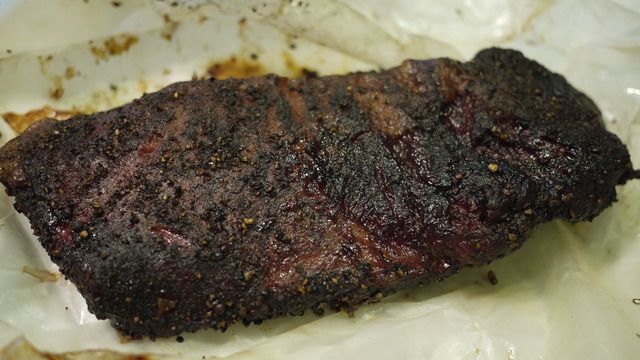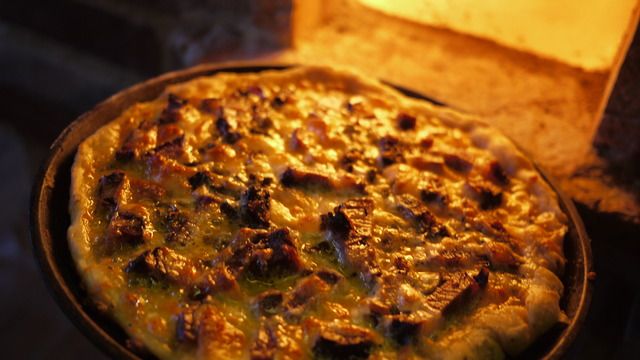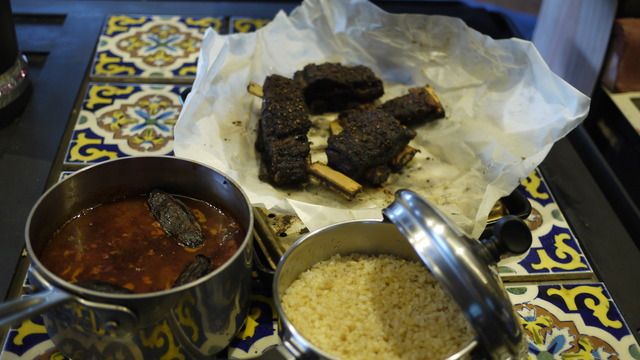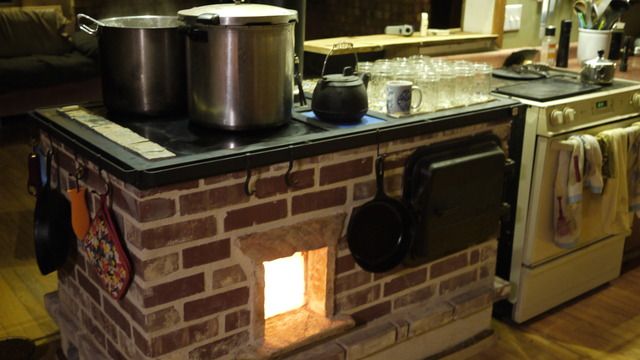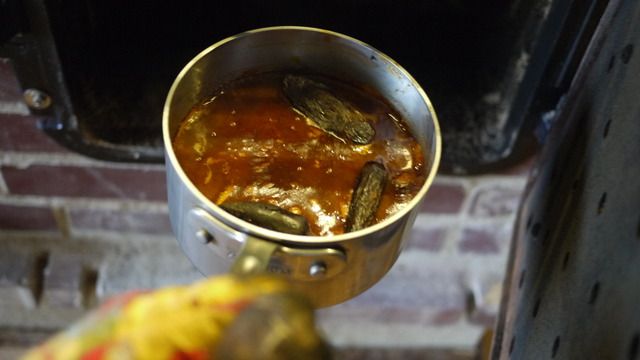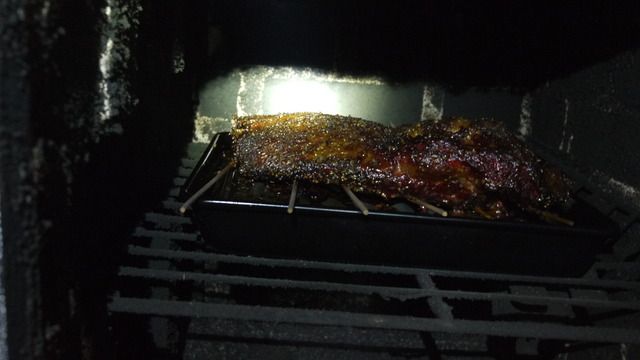|
|
Post by matthewwalker on Apr 4, 2015 6:06:04 GMT -8
I have sorta abandoned the term "rocket" when I talk about this since it doesn't have a riser, but I go back and forth. It runs exactly as my home batch does, and they are for sure rocketing when running. If they aren't, it isn't working, so they are still in the same family. One constant as I've moved through the development process for both of these is that velocity through the port and subsequent chambers must stay above a certain threshold, or things just revert back to a wood stove smouldering type state. I call it "front burn", when the firebox looks like you are having a nice fire but nothing's happening in the port. That's the worst, and it is brought on by poor draft or not enough primary. This one is much more stable than my risered versions, it's actually the best burning heater I've experienced, just lights up the afterburner instantly and with incredible stability. So, yeah, lots of rocket sounds! The oven is amazing, I can't seem to find anything it doesn't do well, even though it's really not that adjustable. I originally built a bypass with the intention of using it not only for start up but for oven temp control. I deleted it after the first few burns as I felt I didn't need it at all and the way I have the oven configured it's difficult to over heat. By the thermometer, it appears to run a little low for most folk's use, which is perfect for me since I like to cook low and slow. However, upon use I've found that it cooks hotter than it shows, I think due to the torque from the mass, maybe? Anyway, a pizza in this thing at 350° comes out looking like I cooked it much hotter. I have baked pies, cakes, bread, pizza, smoked brisket, pulled pork, ribs, beef short ribs, smoked salmon, on and on. It has cooked each pretty much perfectly without a lot of thought from me, just a little more or less wood depending on the desired results. In terms of details of the build, it's just a bell. I found a cast iron insulated door on ebay. That's it, dead simple. Here's a shot of the oven interior with flue input/output and oven rack brick stubs. 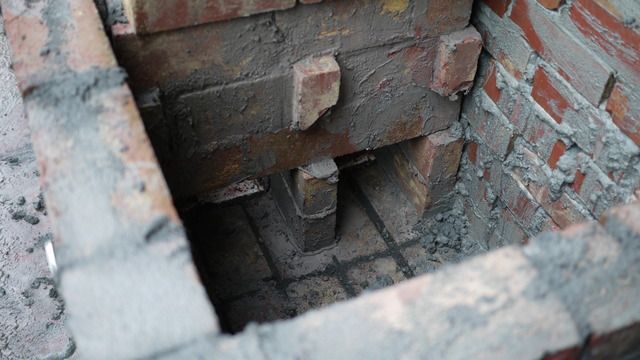 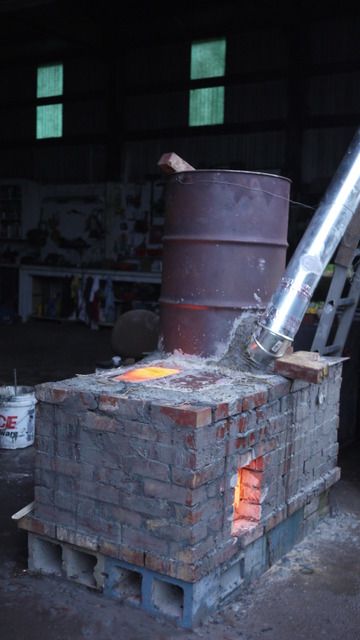 This is the first one I built in my shop in February. Yes, I've built two complete stoves already. I'm still worn out! |
|
|
|
Post by matthewwalker on Apr 4, 2015 6:15:33 GMT -8
|
|
Deleted
Deleted Member
Posts: 0
|
Post by Deleted on Apr 4, 2015 6:57:43 GMT -8
The "ricer" is merely an afterburner, which does not need to be vertical.
You have just redesigned the afterburner and as the gas still raises
at the end your design is obviously still a "ricer".
It is the afterburner, who makes the rocket like sound,
regardless of the orientation.
|
|
|
|
Post by patamos on Apr 4, 2015 17:25:52 GMT -8
Ahh, that makes sense. So Rocket it still is. In a way it has a bit in common with a Winiarski style L-feed with air feeding under a metal plate bottom deck... those pics have made me very hungry  |
|
|
|
Post by shilo on Apr 4, 2015 22:38:28 GMT -8
here is a sketch I made in 10/04/2014 but didn't built it yet... attachment.skp (17.7 KB) |
|
|
|
Post by matthewwalker on Apr 5, 2015 7:07:54 GMT -8
Nice Shilo! This one is definitely a spin on your sided batch, and I was thinking of you guys when I put up the core layout. You should build with it, I think it will fit your goals of small footprint and low height. I can see a lot of very cool designs coming from this format, and would love to see what you could do with it.
|
|
|
|
Post by DCish on Apr 6, 2015 20:02:18 GMT -8
...velocity through the port and subsequent chambers must stay above a certain threshold, or things just revert back to a wood stove smouldering type state. So is that why you have such a long, narrow burn tunnel before the apparently "system-size" square riser stub leading up to the cook top? Perhaps the narrow section is the same CSA only tall and narrow? I had thought of experimenting with a short, fat insulated afterburner chamber to keep the same volume as the riser only without the height, but I worried that such a large void immediately after the throat would let the heat disperse too much, allowing combustion to stop before all combustibles were consumed. Another question: It would appear that your secondary air is delivered at the center [EDIT: center rear] of the firebox, while the throat is in the left corner. As you test, do you think that might be a part of the incomplete CO combustion that Peterberg commented on? On the one hand, secondary air is being delivered farther from the throat. On the other hand, it is still being delivered at the far end of most of the fuel, so perhaps it makes a negligible difference -- perhaps a reasonable sacrifice given how simple it is to construct a straight Walker port vs the added complexity of trying to deliver secondary air an inch or two closer to the throat? Either way, this is incredibly exciting. Can't wait to see dimensions (or perhaps I missed that somewhere?)! |
|
|
|
Post by matthewwalker on Apr 7, 2015 6:16:33 GMT -8
Yeah, I think so DC, and the port is not centered, it is pretty much the same orientation as I use in a PvdB batch. I'm excited too, glad to share man! I don't have any dimensions up, but if you start stacking bricks it will show you how it wants to be. If you get started and get stuck, I'll be happy to fill in the blanks as you build.
edit: Wrote "port" up there but you know what I meant I hope. The secondary air delivery tube is centered in the port, offset in the firebox.
|
|
morticcio
Full Member
   "The problem with internet quotes is that you can't always depend on their accuracy" - Aristotle
"The problem with internet quotes is that you can't always depend on their accuracy" - Aristotle
Posts: 371
|
Post by morticcio on Apr 7, 2015 6:32:23 GMT -8
Matt,
Great build :-)
what size are your bricks?
|
|
|
|
Post by matthewwalker on Apr 7, 2015 6:45:39 GMT -8
Thanks Andy!
They are 9" x 4.5" x 2.5"
|
|
|
|
Post by DCish on Apr 7, 2015 11:26:41 GMT -8
...the port is not centered, it is pretty much the same orientation as I use in a PvdB batch. Oops, my bad. Been looking at it on a small screen and missed the offset secondary air location. Another "hmmmm" regarding the CO numbers... could possibly be related to the heat-shedding window early in the burn tunnel? One cool thing that window demonstrates is that the ceramic glass can withstand the temps of the afterburner area. Very nifty. In the layout I'm considering I'd hope to have the window at the same end as the firebox, looking down the narrow tunnel. Should hold up just fine there, and be late enough in the burn to not effect combustion. Speaking of ceramic glass, is that cooktop anything other than just a big sheet of ceramic glass? Is it from an electric oven, or something more robust than that? |
|
|
|
Post by photoman290 on Apr 7, 2015 16:00:37 GMT -8
is the oven just bare brick with the shelves sitting on those stubs? i like to cook meat really slowly over a long time like several hours. would you get enough residual heat to be able to do that.? thinking of the European communal bake house system where the bread is cooked first then people bring there pots of stew and leave them in the oven to cook as it cools down. when i worked in foundry the foundry workers, mostly indian, would bring there curries and put them around the furnace after a pour. strange mixture of hot iron and curry smells ensued.
|
|
mudder
Junior Member
 
Posts: 50 
|
Post by mudder on Apr 7, 2015 16:47:43 GMT -8
very nice! i need a snack now. wish i could download that meat. lol
|
|
|
|
Post by matthewwalker on Apr 7, 2015 17:25:11 GMT -8
The top is just a range top DC, and I do believe the glass is a compromise.
It does do the residual heat thing, quite well. It would do better with even more mass, right now it's about a 12 hour cool down cycle. It's not quite ambient at that point, but it's not giving off much energy. The shelves were on brick stubs in the first iteration I built in my shop. The one in the house the elevations didn't work out so I used masonry fasteners and little sheeves on the outside wall as rack runners. Still on the stubs on the inboard side.
|
|
|
|
Post by satamax on Apr 7, 2015 23:26:28 GMT -8
Matt, daft me, i might not have seen it; but what is your burn time during the day?
|
|






